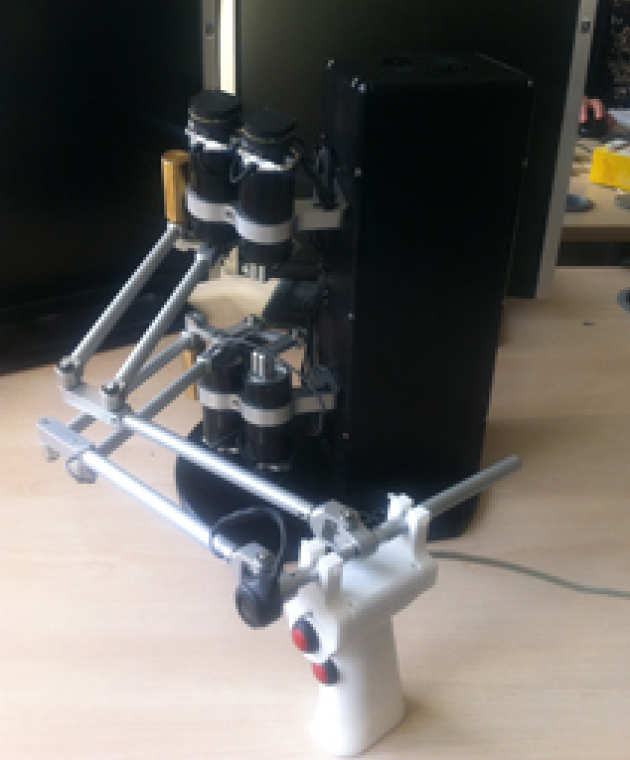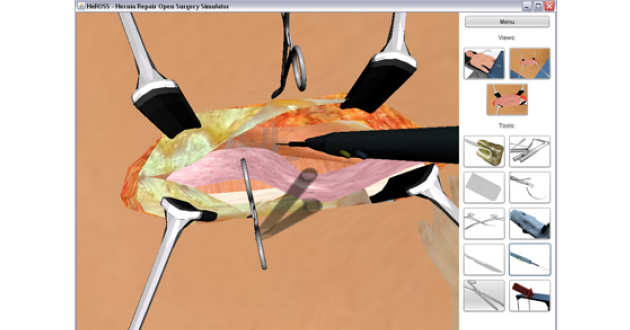
The Research Project
What's the problem area?
A key skill in orthopaedic surgery (and many other disciplines) is precise drilling. Although there are many applications of drilling in surgery, for this project we are focusing on Dynamic Hip Screw (DHS) operations. A Dynamic Hip Screw is inserted into the femur to correct particular kinds of hip fractures and is a very common operation. A key step in DHS surgery is the initial pilot hole drilled using a long flexible drill bit through the outside edge of the femur and up into the head (rounded ball part) of the hip.
What's the challenge?
The accurate positioning of this pilot hole is critical, having a knock-on effect for the rest of the operation and its ultimate success. However, achieving accurate placement is challenging, the surgeon cannot see where the tip of the guide wire is and must rely on x-ray imaging to see their progress. This means that, until a surgeon has perfected their technique, they will need to take many more x-ray images - exposing the patient to unnecessary radiation – and the procedure will take longer, increasing the possibility of complications and raising the cost of the whole operation.
Main Objectives
For a skilled task like this, there is no substitute for practice and experience. Clearly gaining that experience on live patients has consequences and so virtual reality simulation technology, haptics in particular, can fill the gap. By creating a realistic simulation of the important parts of the operation, junior surgeons can practice repeatedly to hone their skills. Unique to a simulated solution the surgeon can also receive detailed feedback such as position, angle and force applied during drilling or even be guided through the ‘perfect’ operation.
The primary objectives of the HOOT project are:
- Assess the requirements of a haptically enabled simulator for training guide wire placement in DHS surgery
- Develop a simulation of guide wire placement in DHS surgery with uni-manual haptic feedback in both linear and rotational degrees of freedom
- Perform a validation study to establish the efficacy of the developed uni-manual simulator
- Develop a simulation of guide wire placement in DHS surgery with bi-manual haptic feedback
- Perform a validation study to establish the efficacy of the developed bi-manual simulator
Current Progress
We are using haptic devices, the W5D from Entact Robotics, to simulate drilling through the bone. In the current version, a 3D printed “drill  handle” is attached to the haptic device. The handle has buttons and switches on it replicate the control of speed, direction and grip on the guide wire which exist on a real drill and has a simple microcontroller inside to communicate the state of the buttons back to the computer over USB. Uncommonly for typical haptic applications to date, we are using the W5D to produce both linear forces (x,y,z) and rotational forces (torques: roll, pitch, yaw). This is important for the DHS application as a large part of the task skill relates to orientation, and controlling this requires precise torque control of the handpiece. The simulation software calculates and commands forces to the device to give the feeling of touching the bone and drilling though.
handle” is attached to the haptic device. The handle has buttons and switches on it replicate the control of speed, direction and grip on the guide wire which exist on a real drill and has a simple microcontroller inside to communicate the state of the buttons back to the computer over USB. Uncommonly for typical haptic applications to date, we are using the W5D to produce both linear forces (x,y,z) and rotational forces (torques: roll, pitch, yaw). This is important for the DHS application as a large part of the task skill relates to orientation, and controlling this requires precise torque control of the handpiece. The simulation software calculates and commands forces to the device to give the feeling of touching the bone and drilling though.
The graphical feedback is made up of three windows, one 3D view approximating the view point of the surgeon (currently without and skin/muscle in the way) and two views representing an X-ray image from the front and the side of the patient, recreating the views the surgeon has access to during an operation.
What Happens Next?
The next phase of the research will focus on improving the realism of the haptic feedback. The algorithms which calculate the drilling and the forces which act on the drill/guide wire will be improved to recreate natural effects such as the difference between different layers of bone and the difficulty the surgeon faces when trying to drill a new hole close to another – the guide wire tends to ‘slip’ back into the first hole.
Following these improvements, we will conduct a pilot validation study investigating how the simulator is perceived by experienced surgeons and what the level of similarity is compared to an actual procedure. We will then use this data to direct our work on the next version.
Our current plans for the next version include a two handed (bi-manual) version and a visual-haptic collocated arrangement to replicate the actions involved in the real procedure much more closely.
Publications & Other Outputs
The HOOT simulator has to date been used by a number of orthopaedic surgeons contributing valuable feedback towards the design and demonstrated at numerous public exhibitions and events.
Barrow, A., Akhtar, K., Gupte, C., & Bello, F. (2012).
Requirements analysis of a 5 degree of freedom haptic simulator for orthopedic trauma surgery.
Studies in health technology and informatics,184, 43-47.
 Simulation-based learning is increasingly accepted not only as a viable alternative to the traditional apprenticeship model, but as a vital component of medical training and safer clinical practice. Surgical simulation is an extremely challenging area of research combining medical imagery, computer graphics, mathematical modelling and Human Computer Interfacing (HCI). Recent advances make it possible to represent and interact with complex tissue structures through suitable haptic interfaces, but a great deal of research in soft tissue modelling, photorealistic 3D models, haptic interaction, physiology and pathology modelling is still needed to develop the next generation of surgical simulators.
Simulation-based learning is increasingly accepted not only as a viable alternative to the traditional apprenticeship model, but as a vital component of medical training and safer clinical practice. Surgical simulation is an extremely challenging area of research combining medical imagery, computer graphics, mathematical modelling and Human Computer Interfacing (HCI). Recent advances make it possible to represent and interact with complex tissue structures through suitable haptic interfaces, but a great deal of research in soft tissue modelling, photorealistic 3D models, haptic interaction, physiology and pathology modelling is still needed to develop the next generation of surgical simulators.
 handle” is attached to the haptic device. The handle has buttons and switches on it replicate the control of speed, direction and grip on the guide wire which exist on a real drill and has a simple microcontroller inside to communicate the state of the buttons back to the computer over USB. Uncommonly for typical haptic applications to date, we are using the W5D to produce both linear forces (x,y,z) and rotational forces (torques: roll, pitch, yaw). This is important for the DHS application as a large part of the task skill relates to orientation, and controlling this requires precise torque control of the handpiece. The simulation software calculates and commands forces to the device to give the feeling of touching the bone and drilling though.
handle” is attached to the haptic device. The handle has buttons and switches on it replicate the control of speed, direction and grip on the guide wire which exist on a real drill and has a simple microcontroller inside to communicate the state of the buttons back to the computer over USB. Uncommonly for typical haptic applications to date, we are using the W5D to produce both linear forces (x,y,z) and rotational forces (torques: roll, pitch, yaw). This is important for the DHS application as a large part of the task skill relates to orientation, and controlling this requires precise torque control of the handpiece. The simulation software calculates and commands forces to the device to give the feeling of touching the bone and drilling though. Endovascular clinicians are largely trained using the traditional apprenticeship model where the trainee or apprentice learns first through observation, and then by gradually assisting and performing surgical procedures themselves under the direct supervision of the senior clinician. Several factors such as the increasing costs of time in the operating room have resulted in a need for alternative out-of-the OR training methods such as virtual reality (VR) simulators [5]. These simulators have the advantage of being adaptable to simulate different anatomies, as well as having haptic feedback that helps to recreate the feeling of handling the tools through the sense of touch.
Endovascular clinicians are largely trained using the traditional apprenticeship model where the trainee or apprentice learns first through observation, and then by gradually assisting and performing surgical procedures themselves under the direct supervision of the senior clinician. Several factors such as the increasing costs of time in the operating room have resulted in a need for alternative out-of-the OR training methods such as virtual reality (VR) simulators [5]. These simulators have the advantage of being adaptable to simulate different anatomies, as well as having haptic feedback that helps to recreate the feeling of handling the tools through the sense of touch.
